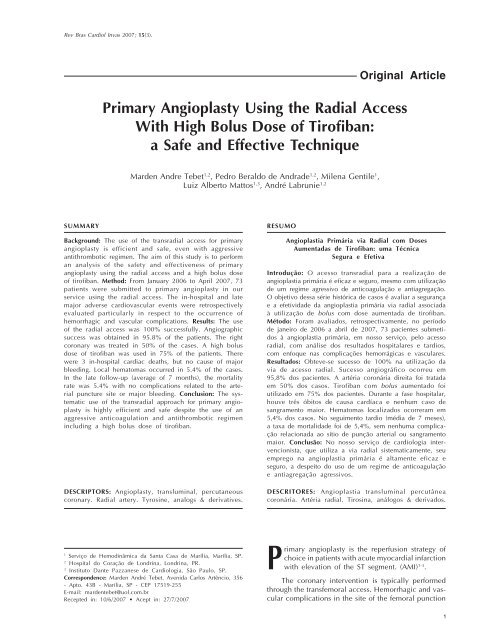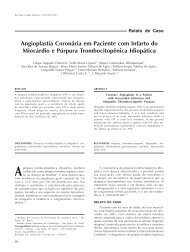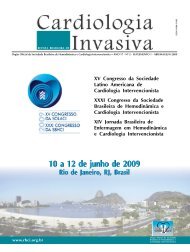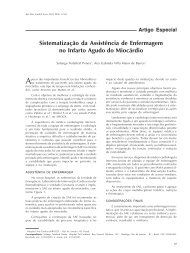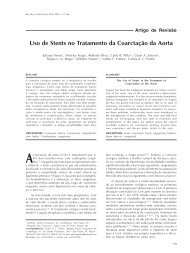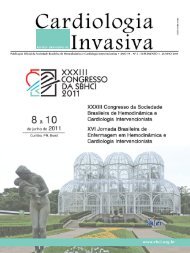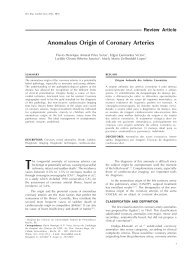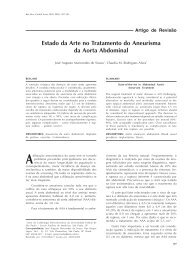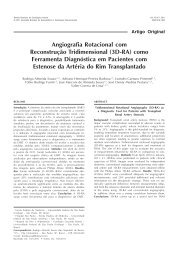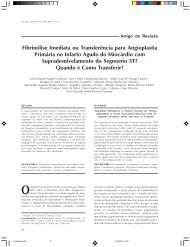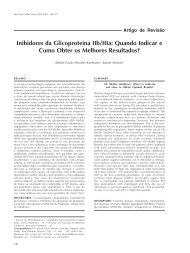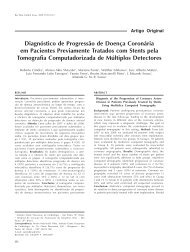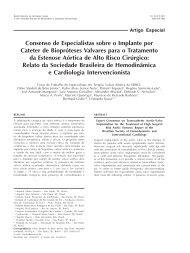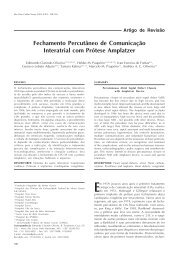Marden Tabet ING.pmd - Revista Brasileira de Cardiologia Invasiva
Marden Tabet ING.pmd - Revista Brasileira de Cardiologia Invasiva
Marden Tabet ING.pmd - Revista Brasileira de Cardiologia Invasiva
You also want an ePaper? Increase the reach of your titles
YUMPU automatically turns print PDFs into web optimized ePapers that Google loves.
Rev Bras Cardiol Invas 2007; 15(3).<br />
Tebet MA, et al. Primary Angioplasty Using the Radial Access With High Bolus Dose of Tirofiban: a Safe and Effective Technique.<br />
Rev Bras Cardiol Invas 2007; 15(3).<br />
SUMMARY<br />
Primary Angioplasty Using the Radial Access<br />
With High Bolus Dose of Tirofiban:<br />
a Safe and Effective Technique<br />
<strong>Mar<strong>de</strong>n</strong> Andre Tebet 1,2 , Pedro Beraldo <strong>de</strong> Andra<strong>de</strong> 1,2 , Milena Gentile 1 ,<br />
Luiz Alberto Mattos 1,3 , André Labrunie 1,2<br />
Background: The use of the transradial access for primary<br />
angioplasty is efficient and safe, even with aggressive<br />
antithrombotic regimen. The aim of this study is to perform<br />
an analysis of the safety and effectiveness of primary<br />
angioplasty using the radial access and a high bolus dose<br />
of tirofiban. Method: From January 2006 to April 2007, 73<br />
patients were submitted to primary angioplasty in our<br />
service using the radial access. The in-hospital and late<br />
major adverse cardiovascular events were retrospectively<br />
evaluated particularly in respect to the occurrence of<br />
hemorrhagic and vascular complications. Results: The use<br />
of the radial access was 100% successfully. Angiographic<br />
success was obtained in 95.8% of the patients. The right<br />
coronary was treated in 50% of the cases. A high bolus<br />
dose of tirofiban was used in 75% of the patients. There<br />
were 3 in-hospital cardiac <strong>de</strong>aths, but no cause of major<br />
bleeding. Local hematomas occurred in 5.4% of the cases.<br />
In the late follow-up (average of 7 months), the mortality<br />
rate was 5.4% with no complications related to the arterial<br />
puncture site or major bleeding. Conclusion: The systematic<br />
use of the transradial approach for primary angioplasty<br />
is highly efficient and safe <strong>de</strong>spite the use of an<br />
aggressive anticoagulation and antithrombotic regimen<br />
including a high bolus dose of tirofiban.<br />
DESCRIPTORS: Angioplasty, transluminal, percutaneous<br />
coronary. Radial artery. Tyrosine, analogs & <strong>de</strong>rivatives.<br />
1 Serviço <strong>de</strong> Hemodinâmica da Santa Casa <strong>de</strong> Marília, Marília, SP.<br />
2 Hospital do Coração <strong>de</strong> Londrina, Londrina, PR.<br />
3 Instituto Dante Pazzanese <strong>de</strong> <strong>Cardiologia</strong>, São Paulo, SP.<br />
Correspon<strong>de</strong>nce: <strong>Mar<strong>de</strong>n</strong> André Tebet. Avenida Carlos Artêncio, 356<br />
- Apto. 43B - Marília, SP - CEP 17519-255<br />
E-mail: mar<strong>de</strong>ntebet@uol.com.br<br />
Recepted in: 10/6/2007 Acept in: 27/7/2007<br />
RESUMO<br />
Original Article<br />
Angioplastia Primária via Radial com Doses<br />
Aumentadas <strong>de</strong> Tirofiban: uma Técnica<br />
Segura e Efetiva<br />
Introdução: O acesso transradial para a realização <strong>de</strong><br />
angioplastia primária é eficaz e seguro, mesmo com utilização<br />
<strong>de</strong> um regime agressivo <strong>de</strong> anticoagulação e antiagregação.<br />
O objetivo <strong>de</strong>ssa série histórica <strong>de</strong> casos é avaliar a segurança<br />
e a efetivida<strong>de</strong> da angioplastia primária via radial associada<br />
à utilização <strong>de</strong> bolus com dose aumentada <strong>de</strong> tirofiban.<br />
Método: Foram avaliados, retrospectivamente, no período<br />
<strong>de</strong> janeiro <strong>de</strong> 2006 a abril <strong>de</strong> 2007, 73 pacientes submetidos<br />
à angioplastia primária, em nosso serviço, pelo acesso<br />
radial, com análise dos resultados hospitalares e tardios,<br />
com enfoque nas complicações hemorrágicas e vasculares.<br />
Resultados: Obteve-se sucesso <strong>de</strong> 100% na utilização da<br />
via <strong>de</strong> acesso radial. Sucesso angiográfico ocorreu em<br />
95,8% dos pacientes. A artéria coronária direita foi tratada<br />
em 50% dos casos. Tirofiban com bolus aumentado foi<br />
utilizado em 75% dos pacientes. Durante a fase hospitalar,<br />
houve três óbitos <strong>de</strong> causa cardíaca e nenhum caso <strong>de</strong><br />
sangramento maior. Hematomas localizados ocorreram em<br />
5,4% dos casos. No seguimento tardio (média <strong>de</strong> 7 meses),<br />
a taxa <strong>de</strong> mortalida<strong>de</strong> foi <strong>de</strong> 5,4%, sem nenhuma complicação<br />
relacionada ao sítio <strong>de</strong> punção arterial ou sangramento<br />
maior. Conclusão: No nosso serviço <strong>de</strong> cardiologia intervencionista,<br />
que utiliza a via radial sistematicamente, seu<br />
emprego na angioplastia primária é altamente eficaz e<br />
seguro, a <strong>de</strong>speito do uso <strong>de</strong> um regime <strong>de</strong> anticoagulação<br />
e antiagregação agressivos.<br />
DESCRITORES: Angioplastia transluminal percutânea<br />
coronária. Artéria radial. Tirosina, análogos & <strong>de</strong>rivados.<br />
Primary angioplasty is the reperfusion strategy of<br />
choice in patients with acute myocardial infarction<br />
with elevation of the ST segment. (AMI) 1-3 .<br />
The coronary intervention is typically performed<br />
through the transfemoral access. Hemorrhagic and vascular<br />
complications in the site of the femoral punction<br />
1
Tebet MA, et al. Primary Angioplasty Using the Radial Access With High Bolus Dose of Tirofiban: a Safe and Effective Technique.<br />
Rev Bras Cardiol Invas 2007; 15(3).<br />
can bring about a significant increase of complications,<br />
time of stay in hospital and cost of the procedure,<br />
especially when the angioplasty is performed un<strong>de</strong>r<br />
the aggressive regime of anticoagulation and antiplatelet<br />
therapy, especially with the use of glico-protein inhibitors<br />
Iib/IIIa (GPI) 4 .<br />
The use of the transradial access is based on the<br />
reduction of hemorrhagic complications in the vascular<br />
access site and long rest in bed. Several studies have<br />
confirmed its applicability and potential advantages<br />
over the femoral approach 5-9 , with equal success and<br />
less hemorrhagic complications, even with the use of<br />
an aggressive anti thrombotic regime, including GPI 4.<br />
In spite of some conflicting results, studies have<br />
established the safety and efficacy of GPIs during primary<br />
angioplasty 10-13 . The current gui<strong>de</strong>lines specifically recommend<br />
the use of abciximab during primary PCI as<br />
a class I 3 indication.<br />
In patients with acute coronary syndromes, the TAR-<br />
GET 14 study showed less efficacy of tirofiban when compared<br />
to abciximab. It is believed that this is due to, mainly,<br />
to an ina<strong>de</strong>quate platelet inhibition in the first hours after<br />
administering tirofiban during the procedure 14-19 . The use<br />
of bolus with an increased dose of tirofiban have shown<br />
platelet inhibition and similar clinical results to those<br />
found with abciximab 20-22 . The substitution of abciximab<br />
for tirofiban, administered with a bolus regime with increased<br />
dose, is a promising strategy, which might show itself to<br />
be cost effective.<br />
The objective of this study is to assess the effectiveness<br />
of primary angioplasty through the radius associated<br />
to the use of bolus with an increased dose of<br />
tirofiban.<br />
METHOD<br />
Between January 2006 and May 2007, 79 patients<br />
with AMI with augmented ST segment were submitted<br />
to primary angioplasty in our service. Seventy-three<br />
patients ma<strong>de</strong> up the sample (92%). Six patients were<br />
exclu<strong>de</strong>d from the sample due to the non-use of the<br />
radial technique: three for lack of radial pulse (two for<br />
previous use of the Sones technique and one due to<br />
previous catheterism and angioplasty through direct<br />
radial approach), two for cardiogenic shock and total<br />
atria ventricular blockage with the need of a temporary<br />
pacemaker, and another patient who evolved with<br />
coronary embolization during an hemodynamic study<br />
for mitral valvulopathy.<br />
Late follow up was obtained in all the patients, either<br />
through their case histories or through telephone calls.<br />
The choice vessel was the right radial. The choice<br />
of the radial technique occurred through the Allen<br />
modified test. If the test were negative, the other vessel<br />
used was the left radial. Short introducers (8 cmts)<br />
were used: French 6. A solution with 5000 UI of heparin<br />
2<br />
sulfate and 10 mg of issosorbi<strong>de</strong> mononitrate was<br />
injected through the introducer. The procedures were<br />
performed with the habitual techniques. Stents were<br />
implanted with the direct or conventional technique.<br />
The removal of the introducers was performed immediately<br />
after the procedure; the haemeostasis was done<br />
with a porous compressive elastic bandage (Tensoplast ® ),<br />
for about four hours. After this period, compression was<br />
relaxed and a small sticking plaster was used during<br />
24 hours. There was no need of haemostatic <strong>de</strong>vices.<br />
The functional circulation of the hand was verified<br />
after one hour.<br />
All patients received 300 mg of aspirin in the<br />
emergency room. Clopidogrel was administered in the<br />
hemodynamic room, using a dose of 300 mg or 600 mg<br />
respectively, with or without tirofiban. Non-fractioned<br />
Heparin was used in all the patients in a total dose of<br />
100 U/kg. Tirofiban was used at the discretion of the<br />
operator, in the dose of 25 u/kg in 3-minute bolus and<br />
in the maintenance dose of 1.5 u/kg/min for 12 – 18<br />
hours. A catheter for the aspiration of coronary thrombi<br />
was also used at the operator’s discretion (Pronto ® ).<br />
The outcomes used were: angiographic success<br />
(percentual of the diameter of the stenosis of the target<br />
vessel < 20% and coronary flux in the target vessel<br />
TIMI 3), general in-hospital <strong>de</strong>ath, complications in<br />
the arterial access – such as major bleeding (<strong>de</strong>terminers<br />
of a long hospital stay, surgical intervention, blood<br />
transfusion or hemorrhagic stroke), arterio-venous fistulae,<br />
ischemia of the limb with the need of vascular<br />
surgery and failure of the procedure, <strong>de</strong>fined as the<br />
need of a second vessel entry or failure of the procedure<br />
due to the impossibility of canalization of the radial<br />
artery or conclusion of the coronary angioplasty or<br />
due to a major complication in the site of the arterial<br />
punction.<br />
The continuous variables were expressed in medians<br />
and standard <strong>de</strong>viation and, the categorical variables,<br />
in absolute numbers and their percentual.<br />
RESULTS<br />
The majority (73.8%) of the patients were male.<br />
There was a low inci<strong>de</strong>nce of patients with a previous<br />
history of myocardial infarction, coronary angioplasty<br />
and myocardial revascularization surgery. The <strong>de</strong>mographic<br />
data is in Table 1. Most of the patients were<br />
unilateral and there was a higher striking of the right<br />
coronary artery (Table 2). Angiographically visible<br />
thrombi occurred in 18 (24.6%) of the patients but<br />
thrombectomy was performed in only 22% of that<br />
population, beginning in October 2006). The bolus<br />
regime, with increased dose of tirofiban, was used in<br />
74% of the patients. In our sample, seven (9.5%) of the<br />
patients were 75 years old or more and out of these,<br />
four (5.4%) used tirofiban without any bleeding episo<strong>de</strong>s,<br />
neither major nor minor. Heparin was not used
Tebet MA, et al. Primary Angioplasty Using the Radial Access With High Bolus Dose of Tirofiban: a Safe and Effective Technique.<br />
Rev Bras Cardiol Invas 2007; 15(3).<br />
after the procedure. Stents were implanted in 69 (94.5%)<br />
of the patients. All exams were performed successfully<br />
through the radial access. The catheters used for the<br />
left and right coronary arteries were the extra back-up<br />
(85%) for the left and Judkins for the right artery (86%),<br />
respectively. Angiographic success took place in 70<br />
(95.8%) of the patients.<br />
Table 3 shows the occurrence of major adverse<br />
events. There were three in-hospital <strong>de</strong>aths. One hap-<br />
TABLE 1<br />
Basic Characteristics<br />
Basic Characteristics Total (n=73)<br />
Mean age 60.8±10.4<br />
Male gen<strong>de</strong>r (%) 51 (69.8)<br />
HAS (%) 50 (68.4)<br />
Diabetes (%) 15 (20.5)<br />
Dislipi<strong>de</strong>mia (%) 26 (35.6)<br />
Family History of ICO (%) 8 (10.9)<br />
Previous AMI (%) 4 (5.4)<br />
Smoking (%) 35 (47.9)<br />
Revascularization surgery (%) 0 (0)<br />
Previous Angioplasty (%) 1 (1.3)<br />
TABLE 2<br />
Angiographic and Total<br />
Procedural Characteristics<br />
Angiographic and procedural Total (n=73)<br />
characteristics<br />
Number of vessels treated<br />
Single artery (%) 35 (47.9)<br />
Bi-artery (%) 23 (31.5)<br />
Tri-artery (%) 15 (20.5)<br />
Vessels treated<br />
DA (%) 30 (41.1)<br />
CX (%) 6 (8.2)<br />
CD (%) 37 (50.6)<br />
Angiographic Thrombus (%) 18 (24.6)<br />
Balloon time (min) 84.3±26.5<br />
Pre TIMI Flux<br />
TIMI 0/1 pre (%) 61 (83.5)<br />
TIMI 2/3 pre (%) 12 (16.4)<br />
Tirofiban Bolus 25 µ/Kg. (%) 54 (74)<br />
Aspiration Catheter (%) 4 (5.4)<br />
Stent implant (%) 69 (94.5)<br />
Post TIMI Flux<br />
TIMI 0/1 post (%) 3 (4.1)<br />
TIMI 2/3 post (%) 70 (95.8)<br />
Angiographic Success (%) 70 (95.8)<br />
pened 12 hours after angioplasty, which was angiographically<br />
successful, due to refractory ventricular fibrillation.<br />
The second <strong>de</strong>ath occurred on the fourth day of<br />
hospitalization, after an unsuccessful angiography (noreflow),<br />
due to refractory cardiogenic shock. The last<br />
patient, admitted for extensive anterior AMI with a 10hour<br />
evolution, presented an angiographic thrombi, more<br />
than 15 mm in extension, without solution through thrombectomy,<br />
GPI and coronary angioplasty, with no-reflow,<br />
died on the second day due to cardiogenic shock.<br />
The late follow up was obtained in 70% of the<br />
patients. During the intermediate follow up, at seven<br />
months, four (5.4%) more <strong>de</strong>aths took place. Of these,<br />
3 happened in the third month after the acute episo<strong>de</strong><br />
and probably due to a cardiac etiology; one patient<br />
presented acute inflammatory abdomen and died in<br />
the fourth month after the AMI. There were no other<br />
complications. There was one episo<strong>de</strong> of subacute<br />
stent thrombosis, during the first week after the procedure,<br />
treated through a new coronary angioplasty, with clinical<br />
success (Table 3).<br />
No major bleeding was i<strong>de</strong>ntified during the inhospital<br />
period. There was no need of a surgical procedure<br />
in the site of the radial punction, blood transfusion,<br />
lengthening of the hospitalization period, no<br />
hemorragic brain stroke episo<strong>de</strong> or bowel bleeding.<br />
There were four cases of hematoma in the site of the<br />
punction, however, without e<strong>de</strong>ma or hand ischemia.<br />
There was one case of localized flebitis which respon<strong>de</strong>d<br />
to clinical treatment.<br />
DISCUSSION<br />
The results of this analysis prove the safety and<br />
efficacy of the transradial access in primary angioplasty,<br />
even with the use of tirofiban, in bolus regime, with<br />
increased dose.<br />
The success of the transradial approach in this<br />
sample is due to the systematic use in our service.<br />
During the same period of the analysis, we performed<br />
327 elective angioplasties (Figure 1). The radial approach<br />
was used in 302 (92.4%) patients, and the femoral in<br />
TABLE 3<br />
Occurrence of events<br />
Clinical Events Total (n=73)<br />
Hospital <strong>de</strong>ath (%) 3 (4.1)<br />
Late follow up (%) 51 (69.8)<br />
Time of follow up (months) 7.26±4.9<br />
Late <strong>de</strong>ath (%) 4 (5.4)<br />
Re-infarction (%) 1 (1.3)<br />
Emergency revascularization (%) 1 (1.3)<br />
Major bleeding 0<br />
Minor bleeding 4 (5.4)<br />
3
Tebet MA, et al. Primary Angioplasty Using the Radial Access With High Bolus Dose of Tirofiban: a Safe and Effective Technique.<br />
Rev Bras Cardiol Invas 2007; 15(3).<br />
Figure 1 - Means of access used in elective angioplasties during<br />
the period from January 2006 until May 2007.<br />
the rest. The success in the elective angioplasties was<br />
98.5%, with ballon angioplasties only in only 5 (1.5%)<br />
patients. The 6F caliber introducers were used in 294<br />
patients (97.3%0, in 3 (0.9%) of patients we used 5F<br />
introducers and, in 5 (1.5%), 7F caliber introducers.<br />
When the right radial approach was not possible, we<br />
opted for the left radial artery for the performance of<br />
the procedure. In cases on which a temporary pacemaker<br />
was necessary, we used the radial access associated<br />
to punction of the jugular vein or even to the<br />
punction of the femoral vein.<br />
This routine access, for the performance of primary<br />
angioplasty, was only implanted after a learning curve<br />
period of the operators, in accordance with several<br />
studies that highlight its importance 23-26 .<br />
In our patients group, there was a predominance<br />
of AMI of the lower wall, clinically stable in most<br />
cases. An eventual major clinical instability, would<br />
potencially contribute negatively to the clinical success<br />
and would <strong>de</strong>termine a higher necessity for the use of<br />
intra-aorta balloon use, which might result in a lower<br />
use of the radial access.<br />
In spite of it having become an option over ten<br />
years ago, for the performance of coronary angioplasty,<br />
in our midst, the radial access is still not much used.<br />
Araújo and Mangione 27 assesed 53.777 patients submitted<br />
to coronary intervention enrolled in the CENIC<br />
(Centro Nacional <strong>de</strong> Intervenciones Vasculares – National<br />
Center of Vascular Intervention). Out of these, 48.455<br />
patients un<strong>de</strong>rwent elective coronary angioplasty and<br />
5.322 in the course of infarct. The radial access was<br />
used only in 10.1% of the elective cases and in 4.6%<br />
in the infarct case patients, with the femoral approach<br />
used in 87.7% of the elective cases and in 91.7 of the<br />
emergencies. It was noticed, that in our country, the<br />
radial access is used in selected patients (Male, with<br />
only one lesion and who had not un<strong>de</strong>rgone previous<br />
surgical revascularization). Patients with more serious<br />
illness are selected for femoral access.<br />
After its introduction by Kiemeneij and Laarman 28 ,<br />
the benefits of the radial technique have been clearly<br />
<strong>de</strong>monstrated in several studies 7 . Hemorragic complications<br />
in the access site are virtually eliminated. After<br />
the procedure, walking and hospital discharge are more<br />
precocious 8 . The morbidity of the procedure is lower<br />
4<br />
and the patients <strong>de</strong>ffinitely prefer this approach to the<br />
transfemoral one 8,29 .<br />
Several studies prove the efficacy and safety of the<br />
radial approach in patients submitted to primary angioplasty<br />
4, 30, 31 . Saito et al. 31 , randomized 213 patients<br />
with AMI within the first 12 hours of the beginning of<br />
the symptoms: 77 were treated with the radial approach<br />
(RTI) and 72 with the femoral approach (FTI). The success<br />
rate of reperfusion and the inci<strong>de</strong>nce of major cardiac<br />
events (<strong>de</strong>ath, non-fatal AMI, repeated revascularization),<br />
during hospitalization, were similar (96.1% and 5.2%<br />
vs. 97.1% and 8.3%) in the TRI and TFI groups respectively<br />
(p = 0.624 and p = 0.444).<br />
Philippe et al. 4 also compared the clinical results<br />
of the transradial intervention (TRI) and transfemoral<br />
intervention (TFI), in primary angioplasty with the use<br />
of abciximab. One hundred and nineteen patients were<br />
prospectively assessed (TRI n = 64 and TFI n = 55). In<br />
that non-randomized study, the free of events overlife was<br />
similar for both techniques (97%0 vs. 94.5%; p = 0.19).<br />
There were no major hemorragic complications in the<br />
TRI group, the opposite to what was found in the TFI<br />
group (5.5%, p = 0.03). The hospital stay was also significantly<br />
longer in the TFI group 5.9 +/- 2.1 vs. 4.5 +/- 1.2<br />
days; p = 0.05).<br />
The glicoprotein inhibitors of the Iib/IIIa are an<br />
adjunct therapy of the utmost importance in the treatment<br />
of AMI, in spite of conflicting results do not show<br />
benefits in the reduction of the mortality rate, when<br />
compared to stent implantation 12 . Abciximab has been<br />
indicated as the class I drug but, due to its high cost<br />
is little used. In comparison to abcximab, tirofiban in<br />
the customary doses (bolus of 10 ug/kg and infusion<br />
of 0.15 ug/kg/min) were less effective, specially in patients<br />
with acute coronary syndrome 14 . The lower event inci<strong>de</strong>nce<br />
provi<strong>de</strong>d by abciximab in that study is due to<br />
the lower inci<strong>de</strong>nce of periprocedure AMI. Differences<br />
were apparent within the next 12 hours, 24 hours at<br />
the most, after the procedure. It was found that the<br />
extension of the inhibition of the agregation was higher<br />
from 15 to 60 minutes from the beginning of the<br />
treatment with abciximab. Schnei<strong>de</strong>r et al. 16 assessed<br />
the dose of the bolus of tirofiban cappable of producing<br />
an agregation inhibition higher than 90%, during the<br />
first hour of treatment, in patients with accute coronary<br />
syndrome, that un<strong>de</strong>rwent PCI. Two dossages where<br />
tested: bolus of 20 ug/kg and infusion of 0.15 ug/kg/min<br />
during 18 to 24 hs or bolus of 25 ug/kg with the same<br />
infusion. The second dossage showed an agregation<br />
inhibition higher than 90% in the first hour. With the<br />
regime used in the TARGET study, the average extention<br />
(bolus of 10 ug/kg and infusion of 0.15 ug/kg/min) gives<br />
an inhibition of the agregation in response to 20 uM<br />
of ADP was 90-94%, in the period of 15 to 60 minutes<br />
after the beginning of treatment with abciximab, and<br />
60 – 66%, after tirofiban 17,18 . The interval of 15 to 60<br />
minutes after the beginning of the treatment, is a critical
Tebet MA, et al. Primary Angioplasty Using the Radial Access With High Bolus Dose of Tirofiban: a Safe and Effective Technique.<br />
Rev Bras Cardiol Invas 2007; 15(3).<br />
period, during which artery lesion takes place due to<br />
the balloon and a metal foreign object, potentially<br />
thrombogenic (stent), is frequently implanted. In this<br />
way, the maximum inhibition of platelet agregation,<br />
during this period, would bring about an ad<strong>de</strong>d benefit.<br />
Srinivas et al. 32 assessed the registry of 7.321 patients<br />
that un<strong>de</strong>rwent primary PCI in the state of New York;<br />
78.5% of which used IGP. The in-hospital mortality<br />
was significantly lower in the patients who used IGP<br />
(3% vs. 6.2%, p < 0.0001). In 2.837 patients, the type<br />
of agent used in primary angioplasty was assessed:<br />
33% received abciximab, 46% eptifibati<strong>de</strong> or tirofiban<br />
and 21% did not receive any medication. The mortality<br />
rate was lower in those abciximab and eptifibati<strong>de</strong> or<br />
tirofiban compared to patients who did not receive<br />
IGP (3.1% vs. 2.4% vs. 4.7% respectively, p = 0.03).<br />
The limitations of the study are its retrospective<br />
character and late partial clinical follow up of the<br />
population. The number of ol<strong>de</strong>r patients, in theory<br />
more propense to complications with the use of the<br />
IGPs, was small. Due to the systematic use of the radial<br />
approach in our service, the femoral approach was<br />
not possible to compare.<br />
CONCLUSION<br />
In our Interventionist cardiology service, which<br />
uses the radial approach systematically, its use in<br />
primary angioplasty is highly efficient and safe, in spite<br />
of the use of an aggressive anticoagulation and<br />
antiagregation regime.<br />
BIBLIOGRAPHIC REFERENCES<br />
1. Keeley EC, Boura JA, Grines CL. Primary angioplasty versus<br />
intravenous thrombolytic therapy for acute myocardial infarction:<br />
a quantitative review of 23 randomised trials. Lancet.<br />
2003;361(9351):13-20.<br />
2. Socieda<strong>de</strong> <strong>Brasileira</strong> da <strong>Cardiologia</strong>. III Diretriz sobre tratamento<br />
do infarto agudo do miocárdio. Arq Bras Cardiol. 2004;83<br />
(Suppl IV):S1-86.<br />
3. Antman EM, Anbe DT, Armstrong PW, Bates ER, Green LA,<br />
Hand M, et al. ACC/AHA gui<strong>de</strong>lines for the management of<br />
patients with ST-elevation myocardial infarction: a report of<br />
the American College of Cardiology/American Heart Association<br />
Task Force on Practice Gui<strong>de</strong>lines (Committee to Revise the<br />
1999 Gui<strong>de</strong>lines for the Management of Patients with Acute<br />
Myocardial Infarction). Circulation. 2004;110(9):e82-292.<br />
4. Philippe F, Larrazet F, Meziane T, Dibie A. Comparison of<br />
transradial vs. transfemoral approach in the treatment of<br />
acute myocardial infarction with primary angioplasty and<br />
abciximab. Catheter Cardiovasc Interv. 2004;61(1):67-73.<br />
5. Lotan C, Hasin Y, Mosseri M, Rozenman Y, Admon D,<br />
Nassar H, et al. Transradial approach for coronary angiography<br />
and angioplasty. Am J Cardiol. 1995;76(3):164-7.<br />
6. Barbeau GR, Carrier G, Ferland S, Letourneau L, Gleeton O,<br />
Lariviere MM. Right transradial approach for coronary procedures:<br />
preliminary results. J Invasive Cardiol. 1996;8(suppl):<br />
19D-21D.<br />
7. Kiemeneij F, Laarman GJ. Transradial artery Palmaz-Schatz<br />
coronary stent implantation: results of a single-center feasibility<br />
study. Am Heart J. 1995;130(1):14-21.<br />
8. Kiemeneij F, Laarman GJ, O<strong>de</strong>kerken D, Slagboom T, van<br />
<strong>de</strong>r Wicken R. A randomized comparison of percutaneous<br />
transluminal coronary angioplasty by the radial, brachial<br />
and femoral approaches: the access study. J Am Coll Cardiol.<br />
1997;29(6):1269-75.<br />
9. Mann T, Cubeddu G, Bowen J, Schnei<strong>de</strong>r JE, Arrowood M,<br />
Newman WN, et al. Stenting in acute coronary syndromes:<br />
a comparison of radial versus femoral access sites. J Am<br />
Coll Cardiol. 1998;32(3):572-6.<br />
10. De Luca G, Suryapranata H, Stone GW, Antoniucci D,<br />
Tcheng JE, Neumann FJ, et al. Abciximab as adjunctive<br />
therapy to reperfusion in acute ST-segment elevation myocardial<br />
infarction: a meta-analysis of randomized trials. JAMA.<br />
2005;293(14):1759-65.<br />
11. Montalescot G, Borentain M, Payot L, Collet JP, Thomas D.<br />
Early vs. late administration of glycoprotein IIb/IIIa inhibitors<br />
in primary percutaneous coronary intervention of acute STsegment<br />
elevation myocardial infarction: a meta-analysis.<br />
JAMA. 2004;292(3):362-6.<br />
12. Stone GW, Grines CL, Cox DA, Garcia E, Tcheng JE, Griffin<br />
JJ, et al. Comparison of angioplasty with stenting, with or<br />
without abciximab, in acute myocardial infarction. N Engl<br />
J Med. 2002;346(13):957-66.<br />
13. Kandzari DE, Hasselblad V, Tcheng JE, Stone GW, Califf RM,<br />
Kastrati A, et al. Improved clinical outcomes with abciximab<br />
therapy in acute myocardial infarction: a systematic overview<br />
of randomized clinical trials. Am Heart J. 2004;147(3):457-62.<br />
14. Topol EJ, Moliterno DJ, Herrmann HC, Powers ER, Grines<br />
CL, Cohen DJ, et al. Comparison of two platelet glycoprotein<br />
IIb/IIIa inhibitors, tirofiban and abciximab, for the<br />
prevention of ischemic events with percutaneous coronary<br />
revascularization. Investigadores do estudo TARGET. N Engl<br />
J Med. 2001;334(25):1888-94.<br />
15. Lakkis N, Lakiss N, Bobek J, Farmer J. Platelet inhibition<br />
with tirofiban early during percutaneous coronary intervention:<br />
dosing revisited. Catheter Cardiovasc Interv. 2002;56(4):<br />
474-7.<br />
16. Schnei<strong>de</strong>r D, Herrmann H, Lakkis N, Aguirre F, Wan Y,<br />
Aggarwal A, et al. Enhanced early inhibition of platelet<br />
aggregation with an increased bolus of tirofiban. Am J<br />
Cardiol. 2002;90(12):1421-3.<br />
17. Herrmann HC, Swierkosz TA, Kapoor S, Tardiff DC, DiBattiste<br />
PM, Hirshfeld JW, et al. Comparison of <strong>de</strong>gree of platelet<br />
inhibition by abciximab versus tirofiban in patients with<br />
unstable angina pectoris and non-Q-wave myocardial infarction<br />
un<strong>de</strong>rgoing percutaneous coronary intervention.<br />
Am J Cardiol. 2002;89(11):1293-7.<br />
18. Kabbani SS, Aggarwal A, Terrien EF, DiBattiste PM, Sobel<br />
BE, Schnei<strong>de</strong>r DJ. Suboptimal early inhibition of platelets<br />
by treatment with tirofiban and implications for coronary<br />
interventions. Am J Cardiol. 2001;89(5):647-50.<br />
19. Schnei<strong>de</strong>r DJ, Herrmann HC, Lakkis N, Aguirre F, Lo MW,<br />
Yin KC, et al. Increased concentrations of tirofiban in<br />
blood and their correlation with inhibition of platelet aggregation<br />
after greater bolus doses of tirofiban. Am J Cardiol.<br />
2003;91(3):334-6.<br />
20. Bolognese L, Falsini G, Liistro F, Angioli P, Ducci K, Tad<strong>de</strong>i<br />
T, et al. Randomized comparison of upstream tirofiban versus<br />
downstream high bolus dose tirofiban or abciximab on tissuelevel<br />
perfusion and troponin release in high-risk acute coronary<br />
syndromes treated with percutaneous coronary intreventions.<br />
The EVEREST trial. J Am Coll Cardiol. 2006;47 (3):522-8.<br />
21. Valgimigli M, Percoco G, Malagutti P, Campo G, Ferrari F,<br />
Barbieri D, et al. Tirofiban and sirolimus-eluting stent vs.<br />
abciximab and bare-metal stent for acute myocardial infarction:<br />
a randomized trial. JAMA. 2005;293(17):2109-17.<br />
5
Tebet MA, et al. Primary Angioplasty Using the Radial Access With High Bolus Dose of Tirofiban: a Safe and Effective Technique.<br />
Rev Bras Cardiol Invas 2007; 15(3).<br />
22. Danzi G, Sesana M, Capuano C, Mauri L, Berra Centurini<br />
P, Baglini R. Comparison in patients having primary coronary<br />
angioplasty of abciximab versus tirofiban on recovery of left<br />
ventricular function. Am J Cardiol. 2004;94(1):35-9.<br />
23. Goldberg SL, Renslo R, Sinow R, French WJ. Learning curve<br />
in the use of the radial artery as vascular access in the<br />
performance of percutaneous transluminal coronary angioplasty.<br />
Cathet Cardiovasc Diagn. 1998;44(2):147-52.<br />
24. Louvard Y, Lefèvre T, Morice MC. Radial approach: what<br />
about the learning curve? Cathet Cardiovasc Diagn. 1997;<br />
42(4):467-8.<br />
25. Teixeirense PB, Gubolino LA, Bragalha AMLA, Toledo JFB,<br />
Franceschine J, Colombo O, et al. Análise temporal dos<br />
resultados imediatos com a aplicação da punção transradial<br />
na intervenção coronária percutânea. Rev Bras Cardiol Invas.<br />
2006;14(4):380-5.<br />
26. Nunes GL, Oliveira AT, Alves L, Alfonso T. Influência da<br />
curva <strong>de</strong> aprendizado no sucesso e na ocorrência <strong>de</strong> complicações<br />
associadas aos procedimentos pela via radial. Rev<br />
Bras Cardiol Invas. 2007;15(2):115-8.<br />
27. Araújo CM, Mangione JA. Diferenças e semelhanças dos<br />
resultados <strong>de</strong> acordo com as diferentes vias <strong>de</strong> acesso. Rev<br />
Bras Cardiol Invas. 2006;14(3):273-9.<br />
6<br />
28. Kiemeneij F, Laarman GJ. Percutaneous transradial artery<br />
approach for coronary stent implantation. Cathet Cardiovasc<br />
Diagn. 1993;30(2):173-8.<br />
29. Cooper CJ, El-Shiekh RA, Blaesing LD. Patient preference<br />
for cardiac catheterization via the transfemoral approach. J<br />
Am Coll Cardiol. 1997;29(Suppl A):310A.<br />
30. Louvard Y, Ludwig J, Lefèvre T, Schmeisser A, Brück M,<br />
Scheinert D, et al. Transradial approach for coronary<br />
angioplasty in the setting of acute myocardial infarction: a<br />
dual-center registry. Catheter Cardiovasc Interv. 2002;55(2):<br />
206-11.<br />
31. Saito S, Tanaka S, Hiroe Y, Miyashita Y, Takahashi S,<br />
Tanaka K, et al. Comparative study on transradial approach<br />
vs. transfemoral approach in primary stent implantation for<br />
patients with acute myocardial infarction: results of the test<br />
for myocardial infarction by prospective unicenter randomization<br />
for access sites (TEMPURA) trial. Catheter Cardiovasc<br />
Interv. 2003;59(1):26-33.<br />
32. Srinivas VS, Skeif B, Negassa A, Bang JY, Shaqra H, Monrad<br />
ES. Effectiveness of glycoprotein IIb/IIIa inhibitor use during<br />
primary coronary angioplasty: results of propensity analysis<br />
using the New York State Percutaneous Coronary Intervention<br />
Reporting System. Am J Cardiol. 2007;99(4):482-5.


